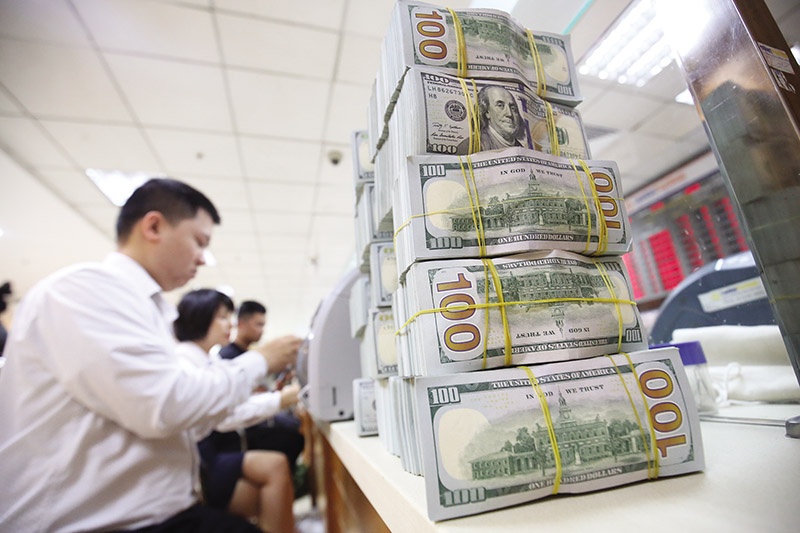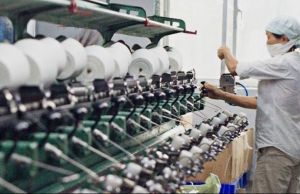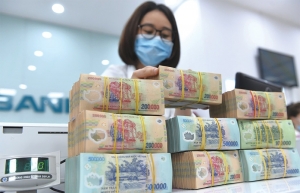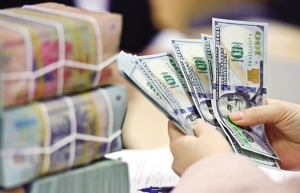Experts share mixed sentiments on forex in 2024
The US Federal Reserve’s most recent meeting on January 31 ended with the interest rates held stable at the highest level in nearly 23 years at 5.25-5.5 per cent.
 |
At the same time, the bank signalled that it has completed raising interest rates, but was not ready to begin cutting rates in the future.
Dinh Duc Quang, cash management executive director at UOB Vietnam, said that the VND-USD exchange rate ended at around VND24,300, with a depreciation below 3 per cent against the US dollar in a year with large volatilities in interest rate policies from major central banks and complicated geopolitical relations worldwide.
This once again shows the stability of VND compared to the US dollar in the face of consistent governance from the central bank (SBV).
“The core factors for this stability in 2023 relate to major balances associated with growth pace, inflation, trade surplus, foreign investment attraction and inward remittances. Entering 2024, our recent report once again continues to have positive assessments of Vietnam’s macro factors and major balances including the stability of the VND-USD exchange rate,” said Quang.
Quang revealed that in the first weeks of 2024, the VND-USD exchange rate at commercial banks had inched up slightly to 24,700, growing at about 1.5 per cent, and that was completely consistent amid the current appreciation of the US dollar compared to major world currencies.
“On the free market, the VND-USD exchange rate has greater fluctuations than in the banking system. The trading volume in this market, however, is minor in the overall activity of the domestic forex market. Therefore, these larger fluctuations, if any, from the free market are not critical factors casting pressure on the stability of the forex market,” Quang said.
Meanwhile, a senior executive at major state lender BIDV said that the domestic forex market was now more difficult to predict in the face of growing connection with the international market.
For 2024, that executive expects the VND-USD exchange rate to be in a slight upward trend of less than 2 per cent overall and that the pattern shall be an up-and-down struggle due to a combination of factors.
First, the landscape in the international environment may pose a moderate pressure as the DXY which reflects the strength of the USD is expected to struggle sideways.
“During the periods when the US economy had a soft landing, such as 1995 or 1998, the US dollar tended to increase slightly in the face of the Fed’s policy transition. I think the current context may be more similar to the period of 1995 or 1998 with the probability of a soft landing for the US economy as higher. Accordingly, the trend of the US dollar Index (DXY) may be sideways, fluctuating in a wide range of about 99-106 points,” said the BIDV leader.
In fact, the DXY has been on steady rise, reaching 103.4 points at the end of January.
Second, in the domestic market, the foreign currency supply and demand balance is expected to be positive with an estimated surplus in the range of $8-10 billion.
Recent strategic partnership agreements with the US and Japan could be a boost for Vietnam's foreign direct investment (FDI) inflow and international trade along the year, although the basic outlook is not entirely favourable amid slowing global growth.
It is forecasted that the trade balance in 2024 may maintain a surplus of about $13-14 billion, while disbursed FDI volume may grow by 8-10 per cent to reach $23-24 billion.
“Leveraging recent experience, the SBV will likely continue to operate exchange rates flexibly with appropriate margins in 2024, and is ready to intervene for stability in times of great pressure,” said the BIDV leader.
“The UOB forecasts a slight increase in the value of the Vietnam dong in 2024 in the prospect that domestic macro factors will improve positively and US dollar interest rates may begin to be cut from mid-2024. The VND-USD exchange rate might be stabilised at around VND23,500-VND24,500 in 2024,” Quang from UOB said.
Ngo Dang Khoa, head of Markets and Securities Services at HSBC Vietnam, predicts that the VND-USD exchange rate might risk going upward in the first quarter of 2024 for several following reasons.
First, the difference in monetary policy approach between the Fed and the SBV will likely remain wide.
Vietnam's current policy priorities supporting growth, while in the US, growth figures are still higher than expectations and core inflation has slowly cooled, causing the Fed to maintain prolonged monetary policy tightening.
Second, VND liquidity in the interbank market is likely to remain ample because there have not been many significant changes in the credit growth as well as the speed of public investment disbursement, at least in the first quarter of this year.
Third, while Vietnam's trade surplus and FDI volume may remain high, some global and regional geopolitical tensions may cast negative impacts on Vietnam's dong.
Fourth, the USD in general is expected to maintain its strength in the first months of 2024, while the Chinese renminbi could continue to be weakened with China's economic rebound being slower than expected.
“However, the exchange rate outlook for the whole year 2024, especially in the second half of the year, will improve when the above factors reverse, especially when the local economy and credit growth gradually resume growth pace. We forecast that the VND-USD exchange rate will end the year at the price range of VND24,400 per USD,” said Khoa.
 | FDI prospects off to stellar start for 2024 Numerous ventures worth hundreds of millions of USD are pouring into Vietnam, promising positive results in foreign investment mobilisation and contributing to economic growth for 2024. |
 | Banking sector gets ball rolling on 2024 performance Forecasts for Vietnam from financial institutions are optimistic for this year, primarily due to policies for reducing interest rates and bolstering digitalisation. |
 | Remittances soar for Lunar New Year 2024 The positive growth trend of remittances during festive seasons 2024 contributes to the stability of exchange rates, the foreign exchange market, and economic growth in Ho Chi Minh city. |
What the stars mean:
★ Poor ★ ★ Promising ★★★ Good ★★★★ Very good ★★★★★ Exceptional
Related Contents
Latest News
More News
- Securing capital and efficiency for Vietnam’s 2026-2030 growth ambitions (December 17, 2025 | 10:00)
- Energy sector in need of blended finance mechanisms (December 17, 2025 | 09:00)
- Vietnam still has room to mobilise capital for sustainable growth (December 17, 2025 | 08:57)
- Long-term capital seen as key hurdle to green growth (December 16, 2025 | 08:00)
- Gold prices swing amid tax debate and import uncertainty (December 15, 2025 | 18:04)
- Agribank frames bank credit as catalyst for green growth (December 15, 2025 | 17:59)
- Vietnam’s green transition demands collective financial action (December 15, 2025 | 12:00)
- VIR workshop highlights capital and policy for sustainable development (December 15, 2025 | 11:00)
- Promoting digital assets initiative in Vietnam (December 13, 2025 | 09:30)
- Experts flag gaps as national financial strategy under review (December 12, 2025 | 15:13)

 Tag:
Tag:



























 Mobile Version
Mobile Version